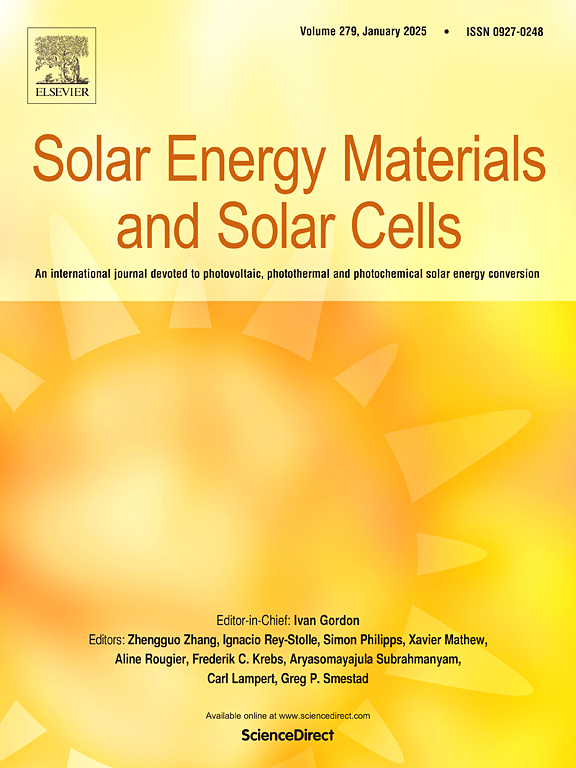Multi-interface porous coating for efficient sub-ambient daytime radiative cooling
IF 6.3
2区 材料科学
Q2 ENERGY & FUELS
引用次数: 0
Abstract
Daytime radiative cooling can achieve a sub-ambient phenomenon passively, holding great promise for energy-saving applications. Polymer coating based on the Mie scattering effect has been widely developed for efficient daytime radiative cooling due to its scalable potential. However, current studies mainly concentrate on the properties of a single scattering interface, neglecting the potential synergistic effects among multiple scattering interfaces. Consequently, we develop a multi-interface porous radiative cooling coating (MIPRC coating) for efficient sub-ambient radiative cooling relying on the emulsion templating method. MIPRC coating consists of three kinds of interfaces with refractive index gradient for photon scattering, including air/polymer, SiO2 particle/polymer, and air/SiO2 particle, resulting in a high solar reflectivity of 97.6 % and an emissivity of 0.964 within the atmospheric window. In radiative cooling experiments, the MIPRC coating achieved a minimum temperature reduction of 5.0 °C below ambient during daytime, and a maximum temperature reduction of 16.0 °C below ambient at nighttime. The corresponding maximum radiative cooling power reached 61.0 W m−2 during the day and 105.5 W m−2 at night. When the MIPRC coating is applied to a foam roof and exposed to ambient air, a roof temperature of 1.2 °C below the ambient under an average solar irradiance of 900W·m−2 is achieved. Building energy-saving measures within 25.8 %–84.6 % can be achieved by applying MIPRC coating in Haikou, Nairobi, Singapore, Miami, and Hawaii. This work provides an untapped perspective on designing highly efficient radiative cooling coatings.
日间辐射冷却可以被动地实现亚环境现象,在节能应用方面大有可为。基于米氏散射效应的聚合物涂层因其可扩展性而被广泛用于高效的日间辐射冷却。然而,目前的研究主要集中于单个散射界面的特性,忽略了多个散射界面之间潜在的协同效应。因此,我们开发了一种多界面多孔辐射冷却涂层(MIPRC 涂层),利用乳液模板法实现高效的亚环境辐射冷却。MIPRC 涂层由三种具有光子散射折射率梯度的界面组成,包括空气/聚合物、SiO2 粒子/聚合物和空气/SiO2 粒子,从而在大气窗口内实现了高达 97.6% 的太阳反射率和 0.964 的发射率。在辐射冷却实验中,MIPRC 涂层在白天的最低温度比环境温度低 5.0 °C,在夜间的最高温度比环境温度低 16.0 °C。相应的最大辐射冷却功率白天达到 61.0 W m-2,夜间达到 105.5 W m-2。将 MIPRC 涂层涂在泡沫塑料屋顶上并暴露在环境空气中时,在平均太阳辐照度为 900W-m-2 的条件下,屋顶温度比环境温度低 1.2 °C。在海口、内罗毕、新加坡、迈阿密和夏威夷应用 MIPRC 涂层可实现 25.8%-84.6% 的建筑节能措施。这项工作为设计高效辐射冷却涂层提供了一个尚未开发的视角。
本文章由计算机程序翻译,如有差异,请以英文原文为准。
求助全文
约1分钟内获得全文
求助全文
来源期刊

Solar Energy Materials and Solar Cells
工程技术-材料科学:综合
CiteScore
12.60
自引率
11.60%
发文量
513
审稿时长
47 days
期刊介绍:
Solar Energy Materials & Solar Cells is intended as a vehicle for the dissemination of research results on materials science and technology related to photovoltaic, photothermal and photoelectrochemical solar energy conversion. Materials science is taken in the broadest possible sense and encompasses physics, chemistry, optics, materials fabrication and analysis for all types of materials.
 求助内容:
求助内容: 应助结果提醒方式:
应助结果提醒方式:


